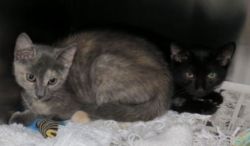CAPIC Rescues Abandoned Kittens Diagnosed with Cuterebrosis
The stories of animal abandonment never end. It was during a rainy day several years ago when an employee of Amwell Pet Supply in Hillsborough, New Jersey, noticed a pet carrier sitting by the dumpster at the nearby Burger King. The person recalls, “Something compelled me to go over to the carrier. I fully expected it to be empty, but to my surprise and dismay, it contained two tiny, rain-soaked kittens.” Then the story gets more interesting.
This good samaritan rushed them over to Amwell Pet Supply. The store has become well-known in the town for hosting weekly cat and kitten adoptions on behalf of CAPIC Cats Rescue for which the owner volunteers.
“We cleaned them up, fed them, and gave them a dry and comfortable place to sleep,” said Hope Valenti, owner of Amwell Pet Supply. “We knew the kittens needed medical care, and at our first opportunity, we took them to our local veterinarian, Belle Mead Animal Hospital, for a thorough exam. To our further dismay, the attending veterinarian discovered that cuterebra worm larvae had lodged underneath the skin in their necks and surgery was required. Those kittens surely would have died in that carrier if not found and rescued that day and given the proper care.”

The condition the kittens were suffering from is called cuterebrosis. Most often seen in late summer and early fall, it starts with a botfly, which is a genus of cuterebra. Botflies lay eggs on blades of grass or in nests. Once the eggs hatch, they release tiny worms or maggots that crawl onto the skin of animals passing by. Often they attach to rodents and rabbits that live in the wild. However, a passing cat or kitten can become infected, too.
In the case of these abandoned kittens, the cuterebra worms most likely crawled around on the kittens until they found an orifice to enter, such as a small wound on the kitten’s neck area. The danger is that once larvae migrate through the cat’s tissues, further illness can follow that include respiratory signs, neurological signs or ophthalmic (eye) lesions.
Because these kittens were diagnosed early and provided with the proper medical care, their prognosis was good, and they were brought out of medical danger.
“A special thanks goes out to the CAPIC volunteer for the great foster care she provided these kittens for a few months,” said Valenti. “With her constant care post-surgery and her daily administration of medications, these kittens survived and we were able to place them in forever homes.”
The attending veterinarian advised that it is important to protect pets from being outside and make sure they don't have any scratches or wounds that can become a home for cuterebra. It is equally important to have your family veterinarian examine pets that come from the outdoors for possible wounds/cuterebra that are covered by fur or often missed.
At least this story did have a happy ending for these kittens.
Susan, Taurus and Gemini